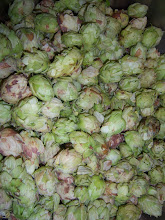 Starting with a rich pine and resin hop nose, Double Simcoe IPA pours a deep copper orange with a light white head. The dry malt front moves almost immediately into the bitterness of the middle, with floral, citrus, pine, and resin flavors and some caramel malt sweetness drawing things together, and ending dry with a pleasant lingering bitterness. Double Simcoe has a soft creamy medium bodied mouthfeel; the carbonation is light, but sparkly in the middle, and helps set up the big bitter finish. There is some slight puckering and dryness on the palate from the large hop load, especially at the end. Overall, a very enjoyable beer, although not for everyday drinkin’—this beer showcases Simcoe’s strengths and complexities quite effectively. And also very American.
Starting with a rich pine and resin hop nose, Double Simcoe IPA pours a deep copper orange with a light white head. The dry malt front moves almost immediately into the bitterness of the middle, with floral, citrus, pine, and resin flavors and some caramel malt sweetness drawing things together, and ending dry with a pleasant lingering bitterness. Double Simcoe has a soft creamy medium bodied mouthfeel; the carbonation is light, but sparkly in the middle, and helps set up the big bitter finish. There is some slight puckering and dryness on the palate from the large hop load, especially at the end. Overall, a very enjoyable beer, although not for everyday drinkin’—this beer showcases Simcoe’s strengths and complexities quite effectively. And also very American.From the Weyerbacher website: “Double Simcoe IPA, 9.0% abv, is our incredible reward for
 Hopheads seeking the intense hop flavor in a Double IPA, without the harshness. It is brewed untilizing only the Simcoe hop variety. This hybrid hop, developed and trademarked by Select Botanicals Group, LLC in the year 2000, was created for its high alpha acid content, maximum aromatic oils, and low cohumulone (harshness) levels so that brewers can really put a lot of ’em in a beer and not create an overly harsh taste.
Hopheads seeking the intense hop flavor in a Double IPA, without the harshness. It is brewed untilizing only the Simcoe hop variety. This hybrid hop, developed and trademarked by Select Botanicals Group, LLC in the year 2000, was created for its high alpha acid content, maximum aromatic oils, and low cohumulone (harshness) levels so that brewers can really put a lot of ’em in a beer and not create an overly harsh taste.Double Simcoe IPA is a full-flavored ale with hints of pineapple and citrus upfront, a good malt backbone in the middle, and a clean finish that doesn’t linger too long. Check it out, and you’ll soon see why everyone’s talking about it. Double Simcoe is available year-round.”
ABV: 9.0%
Today’s BJCP class focused on the brewing process. Having discussed the ingredients (I missed yeast last week) and some of the component parts of brewing, we looked at how to put all of it together. Adding to our examination of mashing, we discused lautering, specifically recirculation (vorlauf) and sparging, and further discussed the multiple functions of boiling, including isomerizing alpha acids from the hops, coagulating and precipitating wort proteins and tannins, and evaporating undesirable aromatics. We rounded this out be examining the different ways of chilling hot wort quickly and efficiently, and finished by talking about packaging, maturing, and carbonating beer. Our sampling was also a bit more eclectic; because some of our classes got condensed, we mixed and matched with the tasting:
10B. American Amber: North Coast Red Seal Ale
10C. American Brown: Bell’s Best Brown
11C. Northern English Brown: Hobgoblin
16C. Saison: Dupont Saison
16D. Biere de Garde: At. Amands French Country Ale
19A. Ole Ale: Fuller’s 1845
19B. English Barleywine: Thomas Hardy’s Ale
19C. American Barleywine: Bigfoot Sierra Nevada
(11/14/2009)

No comments:
Post a Comment